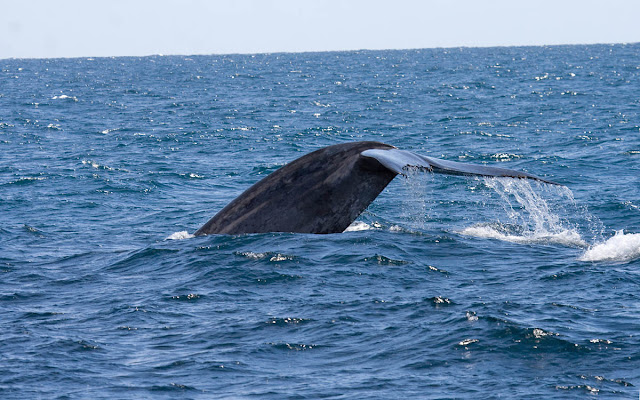The May 21 pelagic birding trip out of San Diego was a great success. I'll be writing about it soon. One of the highlights about 30 miles offshore was a rather close Blue Whale. It dove as we first approached and we decided to wait 10-15 minutes for it to resurface. Even though this was not a bird, it was a great decision. A Black-foooted Albatross flew up to investigate what we were doing! As soon as the albatross landed to eat popcorn and pose for some photos, the whale surfaced.
It has been 10 years since I saw
my first Blue Whale. It left a lasting impression on me. I wrote at the time:
"The huge geyser of a spout hung in the air. The dual blow-holes were like washtubs. The smooth, almost translucent blue back kept rolling and rolling until the small dorsal fin finally arose. And then, during the dive, the huge flukes lifted up like a rising apparition, water pouring off every surface. My knees are still weak from being so close to this huge, gentle, monster."
 |
| The spout of Blue Whale is typically 30 feet tall. |
Information from
Wikipedia follows.
Whaling
Blue Whales are fairly fast. Thus, it wasn't until special whale hunting steamships were invented (primarily from the 1890's) that significant numbers of Blue Whales were killed. Peak hunting was from 1930 to 1946.
Worldwide, whale hunting into the 1970's plummeted Blue Whale numbers to the point of extinction (650-2,000 animals). Though Blue Whale populations in Antarctica are recovering at about a 7% per year clip, they remain at only 1% of their original numbers there. The world wide total number of Blue Whales today (5,000-12,000 animals estimated in 2002) is less than 5% of the pre-steamship whale hunting numbers of 275,000. Blue Whale populations in the western Pacific (Japan) have not recovered.
The California population of Blue Whales was never very high. The population today has returned to pre-hunt numbers (2,200 animals).
 |
| The blow hole is on the top of the head. |
The biggest animal to have ever lived on earth
Everything about the Blue Whale is B-I-G. The creature grows regularly to 80 feet in length, sometimes close to 100 feet. They weigh 80-150 tons. The tongue weighs 3 tons. The heart weighs 400 pounds. The penis is 8-10 feet long. At birth the calves weigh 6,000 pounds, drink 100 gallons of milk every day, and gain weight at the rate of about 200 pounds per day.
 |
| 75% of the whale is in front of the dorsal fin, which is typically only 9-11 inches tall. |
On the other hand, the food that Blue Whales eat--krill--is T-I-N-Y.
Krill are shrimp-like swimming crustaceans only 1-2 centimeters (1/16th of an inch is in the middle of this range).
No dieting allowed
While an average adult human may require 2000 calories per day, an adult Blue Whale requires a daily intake of 1.5 million calories! That means straining out of the water up to 40 million krill, equal to 7,900 pounds of krill, every day.
Trivia bonus box:
Food calories are actually kilocalories, or 1000 calories. A calorie is the heat necessary to raise one gram of water 1 degree Celsius. The food calorie, or kilocalorie, is the heat required to raise a kilogram (1 liter or a bit more than a quart) of water 1 degree Celsius (1.8 degrees Fahrenheit).
|
 |
| The back is so long that the spout and dorsal fin are not seen above the water at the same time. |
Here is the final dive sequence...
 |
| Arching the long blue-gray back in preparation for a deep dive... |
 |
| The last 25% of the whale... |
 |
| A waterfall pours off the flukes... |
 |
| Typical Blue Whale fluke shape. |
For more information on at-sea identification of the 3 largest whales: Blue, Fin, and Sei, check out the
Wild Whales website sponsored by the Vancouver Aquarium.









No comments:
Post a Comment
I really want to hear from you! I've changed settings (again) in order to try to make commenting easier without opening it up to spammers. Please note, however, that comments to posts older than 14 days will be moderated. Thank you.